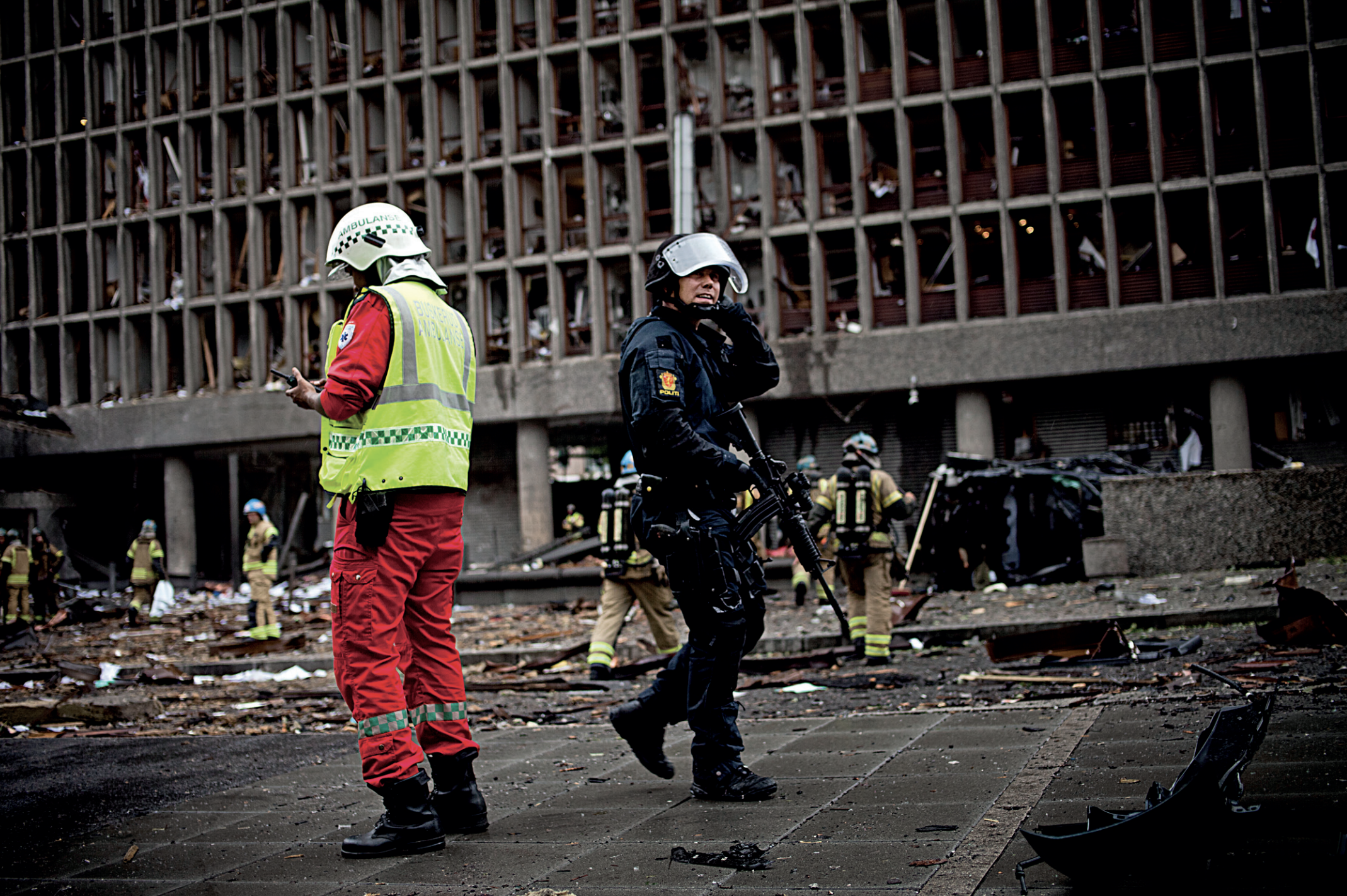It started with the entire building shaking and a gut-wrenching boom. Reporters in the downtown newsrooms got up from their desks and ran to the closest window to look outside.
Only a few seconds later, the first report of the blast was posted on Twitter. “Holy crap. Did Oslo just explode?”
It was 3.25 PM on a lazy summer Friday afternoon, the 22nd of July 2011. The most dramatic news cycle in Norway since the Second World War had started.
That first tweet about the mayhem conducted by a lone right-wing terrorist who had detonated a homemade fertilizer bomb at the main entrance of the government building did not come from any of the major news outlets but from a private citizen. For broadcasters in 2011, online news was still more of a curiosity. A story-centric workflow was something only a few early adopters had heard of.
Before the day was over, 77 people were killed. Eight perished in the explosion at the government complex. The terrorist gunned down the remaining 69 at a summer camp for youth outside Oslo, where he traveled after the downtown bombing. 59 of the victims were under the age of 21.
All the national news organizations in the Norwegian capital immediately sprang into breaking news mode. TV 2, Norway's leading commercial broadcaster, the only one with a 24/7 rolling news channel, was on-air with live footage and a reporter on the scene 23 minutes after the blast, despite significantly reduced manpower during the height of the Norwegian summer holiday. The rapid response was made possible primarily because of fully automated control rooms. The public broadcaster NRK followed 15 minutes later, interrupting scheduled programming.
At the time, the TV 2 newsroom was divided into several different departments. Among them were the prime-time news desk, the 24/7 rolling news desk, and the online news desk.
Each of the three departments went into overdrive. The rolling news desk called the police and other sources. The online guys did the same. The prime-time news reporters followed soon. Sources experienced getting calls from several reporters from TV 2 in minutes, asking the same questions. The different news departments in the same media house were, in reality, operating as competitors, stumbling over each other.
A story-centric workflow in the newsroom was still a thing of the future.
What if?
In the chaotic hours after the attack, the major broadcasters reported on their traditional platforms. In 2011, news still did not break on people's phones. TV reporters viewed the online staff tucked away in the most remote corner of the newsroom with amusement and almost pity, not proper journalists. What was the World Wide Web on a clunky desktop ethernet-wired computer compared to the kings of live TV news? A mobile-first approach was still a few years in the future. In the TV 2 food chain, the prime-time news staff even thought of themselves clearly above the 24/7 news channel, which had a minuscule market share compared to the major late-night news shows. Great journalism was not shared between departments, which could have elevated all the platforms.
It was hardly an environment that invited collaboration. Hence, sub-par workflows were allowed to be established.
Fast-forward 13 years, those workflows prove surprisingly stubborn to get rid of. Even when TV ratings are plummeting, and the online side of the newsroom is approaching the point where it will be even more important than the TV news in terms of speed to market and audience reach, there is reluctance to change.
The plot thickens
All news operations in 2024 are under financial pressure. All editors-in-chief are struggling to get more out of lesser resources. The news cycle has shifted; it now starts in the morning on people's smartphones. The major TV news shows at night hardly bring breaking news to the table and are moving to providing a summary of what has happened throughout the day.
Of all the disruptive technologies that have emerged in the media industry over the past few years, newsgathering and the fast turnaround production and delivery of breaking stories to many platforms is one of the most significant. Operating at the ‘speed of news’ is no longer a luxury but a necessity in today’s highly competitive landscape.
The story-centric workflow has been introduced as the solution to the new reality. But how can it be established successfully? Why do some news organizations trying to introduce story-centricity feel they have failed?
How to make story-centric work
Make no mistake: a story-centric workflow hugely benefits any news organization. It frees up resources that can be applied elsewhere - to produce more and better journalism - and reduce costs.
However, two key equally essential elements must be in place to conduct a story-centric approach successfully.
- A fully committed organization willing to change.
- The right newsroom system.
Looking back on those disorganized and unmanageable hours after the terrorist attack in Norway and analyzing the news output, one thing stands out. Twitter was an essential source of news. However, the tweets did not come from the established media but from private individuals. The live on-air TV presenters were referring to tweets from eyewitnesses. But at the time, the broadcasters did not have their social media teams.
Nowadays, any forward-leaning broadcaster has a social media team responsible for various social platforms. But typically, they are added as yet another newsroom department, amplifying silos that keep working side-by-side without proper collaboration.
It’s all about the workflows
A story-centric approach in the newsroom means organizing the reporting around the story and not regarding what platform the story will be published on. The idea is to have the entire newsroom, regardless of platform, collaborate with newsgathering and fact-finding in one single master story. Raw material, images, video and audio files, documents, sources, and contact info - everything is collected and stored in the master story that reporters from different departments can tap into to find material for piecing together a version suitable for any publishing platform.
If a reporter from the breaking news desk has conducted a video interview with a source, the raw file will be uploaded to the master story. If a reporter from the evening news desk needs a quote from the same source for the News at Nine show, there’s no need to interview the source again, as we know happens every single day in newsrooms all over the world.
And, of course, looking back on July 22nd, 2011, and the lack of media SoMe presence during those critical hours, the social media teams, which have become an essential part of any significant broadcast operation in the last decade, can lift content needed for SoMe posts from the same master story.
How to fail
Organizations that have tried and failed to apply a story-centric workflow typically make the same mistakes. They think that by changing to any NRCS allegedly suitable for story-centric work, pieces will fall in place. But it’s about more than just a new system. The workflow in the newsroom must be adjusted. And the entire organization has to commit to a new way of working. A story-centric approach will not function properly if different teams are allowed to establish their own workflows outside of the system.
In newsrooms where a story-centric workflow has been truly successful, the decision has been top-down. It takes a commitment from the head of news to go all in on the project and make the entire organization march in sync. Change management will, in some cases, be required because, let’s be honest, journalists are notoriously reluctant to change their way of working. They will need guidance and sometimes even hand-holding. But when properly executed, with the organization committed and trained, the story-centric workflow will elevate any news operation.
- Journalists collaborate across different platforms and departments within the newsroom. This interdisciplinary approach ensures that stories are crafted to suit various mediums, including broadcast, online, and social media.
- The digital platforms allow broadcasters to provide real-time updates on unfolding events not only on TV but also on other platforms where users consume media - to help drive viewers to the news shows.
- The usage of mobile apps and push notifications to alert users about breaking news ensures the audience remains engaged and informed and tunes into live broadcasts.
- Active use of social media platforms is a way to interact with the audience, with the sharing of stories, feedback-gathering, and incorporation of audience opinions into reporting. Social media becomes a tool for not only disseminating information but also for building a community around the news brand.
- With the increasing use of smartphones for news consumption, broadcasters can adopt a mobile-first approach in designing their content. News is made easily accessible and readable on various devices, prioritizing a seamless user experience.
So what about the systems?
A functioning workflow is only half of the equation to succeed with a story-centric approach. The right newsroom computer system is also essential.
- The entire newsroom must work together in the same NRCS.
- The system must be able to publish to any platform.
- All assets must be accessible within the system.
- Content must be searchable and seamlessly sharable.
- Integration to live feeds and live production (like LiveU) is essential.
- Chat solutions for fast communication in the newsroom are critical.
- The system must be continuously updated and developed.
- Updated versions must immediately be available for the newsroom.
Only Software-as-a-Service systems check all the boxes. Legacy on-prem newsroom systems updated every five to ten years will not make the cut. The rapid development in the area of cloud computing will make broadcasters clinging to the old ways rapidly fall behind. AI-driven tools will be out of reach.
Broadcasters who continually evolve their strategies to meet the changing demands of the digital age and ensure their stories resonate with diverse audiences will be the winners in an ever more fragmented media landscape.
Key takeaways
It does not have to be a significant story, such as the terrorist attack in Norway, to get news organizations to benefit from a story-centric approach. The principle applies to any story newsworthy for two or more platforms. As long as work is organized around a master story, the traditional pitfalls of double and triple work and repetitive tasks will be eliminated.
A story-centric driven newsroom will reduce costs.
A story-centric driven newsroom will provide better journalism.




